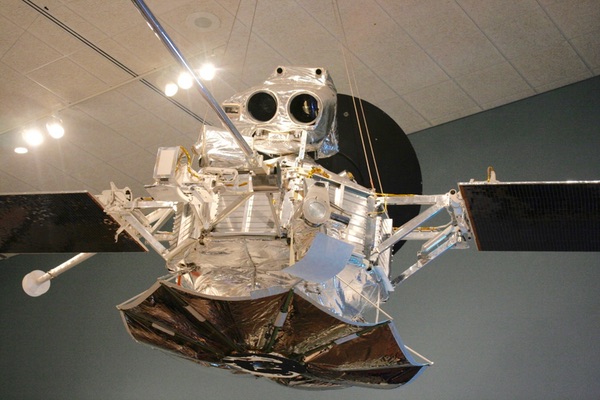Express elevator to Hell: Missions to explore the Sun’s nearest neighborby Dwayne A. Day
|
| Looking at the mission summaries produced by JPL four decades ago, it is obvious that many of the spacecraft that NASA later built—like Magellan, Galileo, even Curiosity—were either first proposed or substantially refined in the early-mid-1970s. |
But flybys only provided limited data about Mercury, and what scientists wanted was to orbit the planet. The first proposal to send a spacecraft into Mercury orbit was made in the mid-1970s, but it was not until the mid-1980s that a Jet Propulsion Laboratory trajectory specialist figured out a way to get a spacecraft into Mercury orbit with decent-sized payload, and only in 2011 did NASA finally accomplish that goal. In between, there were a lot of studies and proposals, as various scientists and engineers tried to figure out the best way of getting a spacecraft to a tiny, speedy planet inconveniently close to a very hot ball of gas.
Hot summer
In the summer of 1974, the National Research Council’s Space Science Board held a series of meetings of its component panels such as the Committee on Planetary and Lunar Exploration, or COMPLEX. COMPLEX was assigned the task of reviewing possible planetary missions for the next decade.
In preparation for this activity, the Jet Propulsion Laboratory conducted nearly a dozen individual studies of new planetary missions, some of them based upon existing spacecraft designs adapted for new missions, and others requiring entirely new spacecraft. Two of the studies focused on the planned arrival of the comet Encke in 1980, one mission involved a Venus orbital imaging radar, another a solar electric out-of-the-ecliptic probe. Other missions focused on Mars, including a polar orbiter, sample return, and a Mars rover. A couple of missions were for a Jupiter/Uranus flyby with Uranus atmospheric probe, and a Jupiter orbiter. Looking at the mission summaries produced by JPL four decades ago, it is obvious that many of the spacecraft that NASA later built—like Magellan, Galileo, even Curiosity—were either first proposed or substantially refined in the early-mid-1970s.
One of those 1974 mission proposals was for a “Mariner Mercury Orbiter 1978,” a spacecraft that could be launched in July 1978 atop a Titan IIIE-Centaur rocket and enter orbit around Mercury in May 1980 with an orbital lifetime of four months. The spacecraft would have had an injected mass of 3,120 kilograms and an orbited mass of 775 kilograms, with the difference being the massive amount of fuel required to bring the spacecraft into orbit around Mercury. The instrument mass would have been only 68.4 kilograms.
The mission objectives would have been to map Mercury’s surface at 500-meter resolution, make extensive measurements of the magnetospheric environment, test the theory of gravitation using three different experiments, determine Mercury’s mass distribution, and determine the abundance of radioactive nuclides on the surface for composition studies. To accomplish this, the spacecraft would be equipped with two imaging cameras, two magnetometers, a 14-channel ultraviolet airglow sensor, a charged particle telescope, plasma science instruments, an infrared radiometer, and a gamma-ray spectrometer.
The spacecraft would have been what JPL referred to as the “Mercury Venus Mission ’73 spare,” otherwise known as the backup to Mariner 10, equipped with a new propulsion subsystem. Mariner 10 was a Venus and Mercury mission and the last of the Mariner missions, although the two Voyagers were initially given Mariner designations.
Mariner missions included backups in case of launch or spacecraft failures, which happened more often than anybody liked. But Mariner 10 was not planned to have a fully flight-qualified spare. According to Bruce Murray and Eric Burgess in their 1977 book Flight to Mercury, originally JPL planned on building an engineering spare that would not have all the components required for flight. However, they saved sufficient money on the primary spacecraft that they procured a full set of flight hardware for the backup, enabling it to fly if the primary spacecraft failed. When the mission was successful, the backup went into clean-room storage.
For the Mercury orbiting mission, the spacecraft would require new thermal protection for its closer proximity to the Sun, an attitude control system developed for the Viking Orbiter, and hot-gas attitude control jets. The instrument suite would be slightly different from Mariner 10. A wide-angle field of view television similar to the one developed for Mariner 9, which was launched to Mars in 1971, would have been used and the ultraviolet occultation spectrometer deleted because it was unnecessary. The Viking Orbiter fuel tank would have been stretched about 0.6 meters. The spacecraft would trade out the 300-pounds-force Viking engine, which was not sufficient to deal with slowing down the spacecraft so deep in the Sun’s gravity well, and instead use a 900-pounds-force reaction control thruster engine developed for the Space Shuttle.
The spacecraft would have been launched atop the most powerful American rocket then in service. It would conduct two swingbys of Venus a year apart and would then be inserted into a 24-hour elliptical orbit inclined 70 degrees, with the northern-hemisphere periapsis at 500 kilometers altitude but its apoapsis much farther out. This orbit would have allowed the spacecraft to map Mercury’s surface, gravitational field, and magnetosphere during its short lifetime in orbit. The final orbit inclination would have been selected by a science steering group, but would probably be between 110 and 135 degrees. Getting an orbit that went over Mercury’s poles was important for several reasons, including that it enabled the spacecraft to cover more of the surface.
| The report included a table that indicated that a Mercury orbiter was part of its “recommended program,” but a Mercury orbiting mission was not explicitly called out in the text of the report. |
The proposed trajectory meant a slow transit time to Mercury, but it resulted in the lowest retro velocity that JPL’s trajectory experts could achieve. That was the biggest challenge for any Mercury orbiter: launching from Earth towards the Sun was essentially launching downhill, requiring a lot of fuel to slow down to enter Mercury’s orbit rather than shoot past it and burn up.
In 1975, the National Research Council’s Space Science Board presented the results of its broad review of possible activities in the space sciences. COMPLEX’s findings about solar system exploration were incorporated into the SSB’s report “Opportunities and Choices in Space Science.” The primary recommendation for planetary science for NASA was to pursue a mission to return a sample from the Martian surface—something that remains an unachieved top priority for the planetary science community more than 40 years later. Other top priorities were to pursue outer planets research. The report did address the inner planets and the Moon, but these were clearly lower priorities. With regards to Mercury the report included a table that indicated that a Mercury orbiter was part of its “recommended program,” but a Mercury orbiting mission was not explicitly called out in the text of the report.
Slowing down
In spring 1976, NASA Headquarters commissioned a “Mercury Orbiter Transport Study” from Science Applications Incorporated that was presented to NASA in January 1977. The study was intended to “assist NASA planners to assess the trajectory/payload performance requirements of candidate flight modes in delivering spacecraft systems to orbit the planet Mercury.”
The study looked at three different flight modes, 15- and 21-kilowatt solar electric propulsion options, and a solar sail, and identified a range of transit times and payload masses for Mercury missions. The report’s authors’ primary conclusion was that all three options were preferable to a more straightforward “ballistic trajectory” to Mercury like that proposed in the earlier JPL study.
Three years after COMPLEX’s report essentially de-emphasized Mercury, in 1978, the COMPLEX committee issued the report “Strategy for Exploration of the Inner Planets.” The report outlined the scientific goals for the exploration of Mercury including mapping, at a resolution of 100 meters or better, the half of the planet’s surface that had not already been imaged.
The report stated that “At present, the U.S. capability is limited to ballistic-type launches, and the opportunities for such launches to insert an appropriately instrumented payload into a circular orbit of Mercury are precluded by one or more” constraints. These included small injected payload mass, few launch windows, long flight times, and the ability to achieve only highly elliptical orbits “which would seriously degrade the resolution and coverage of surface chemistry, surface imagery, and heat-flow experiments.” The report recommended waiting until a “low-thrust” propulsion system—i.e. an ion engine or electric propulsion system—became available. But if such a system became available, the committee recommended that a Mercury mission be adopted late in the period 1977–1987, provided that it did not “detrimentally affect” the study of Earth, Mars, and Venus.
Although there is no direct documentation to indicate it, apparently COMPLEX was not impressed with the proposed orbital mission using the Mariner 10 backup. Without high-level scientific support, the Mercury orbiter mission did not get NASA approval. NASA had higher priority science missions by the later 1970s, and planetary missions were already competing with astrophysics for funding. Of all the possible targets in the solar system, Mercury was not at the top of the priority list for further study, even if it could be accomplished with a spare spacecraft. Soon planetary science entered a period of stagnation in the 1980s, what some referred to as the “lost decade” when no new planetary missions were launched. The Mariner 10 backup was taken out of clean room storage and donated to the Smithsonian. In 2013, it was finally put on display in the museum’s “Time and Navigation” gallery in Washington, DC.
Orbital maneuvers in the light
For the next decade, planning for a Mercury orbiter was essentially nonexistent. NASA’s planetary science program was focused upon other goals. At the time, NASA was making no progress with solar sails, and was unwilling to commit to solar electric propulsion. For Mercury advocates, there was little reason to hope for a possible mission. But the situation was about to change.
| Yen’s work energized people interested in further exploration of Mercury, and soon new studies of Mercury missions were undertaken by various groups. |
In 1985, JPL orbital dynamics expert Chen-Wan Yen turned his attention to Mercury. He crunched the numbers for a range of launch windows and trajectories and demonstrated that it was possible to launch a spacecraft toward Mercury and by doing multiple flybys of the planet, combined with small propulsive maneuvers, put a relatively small spacecraft into orbit. Although the flight times were relatively long, on the order of three to five years, the benefit of this approach was that it was possible to place a larger payload into Mercury orbit than previous options. Even better, these trajectories could use the inexpensive and venerable Delta II launch vehicle.
Yen’s work energized people interested in further exploration of Mercury, and soon new studies of Mercury missions were undertaken by various groups. In 1985, ESA conducted a preliminary Mercury orbiter study. In 1990–1992, the Russian Academy of Sciences’ space science department conducted informal Mercury orbiter studies. Also starting in 1992, Japan’s ISAS science agency considered a Mercury orbiter as a candidate for its “Planet C” mission. Clearly, interest in Mercury was heating up.
In 1988, Yen led a JPL study of a Mercury orbiter mission design and, that same year, NASA’s Space Physics and Planetary Exploration Divisions supported a joint effort led by the Goddard Space Flight Center that consisted of several workshops and studies over the several years. In February 1991, NASA published the results of the Mercury Orbiter Science Working Team. The team outlined the science goals for any new mission to Mercury. The group also defined a basic mission to Mercury.
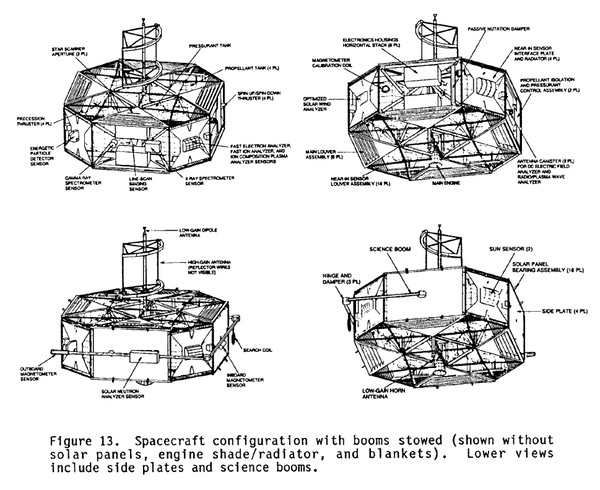 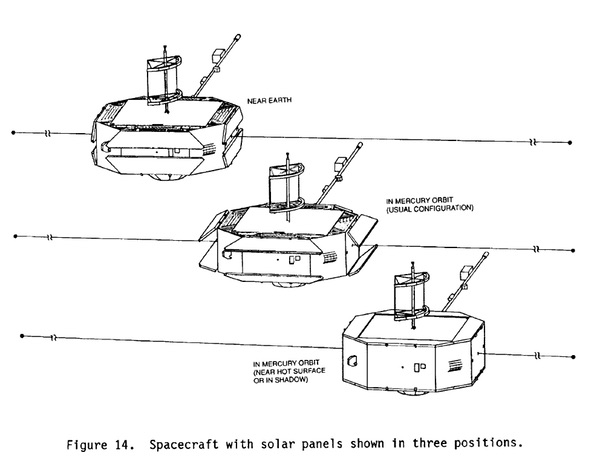 Goddard Space Flight Center proposal from 1991 for a dual-orbiter mission to Mercury. Two spacecraft would have been carried aboard a Titan IV Centaur rocket. This would have been an expensive mission and was not approved. A scaled down version of this mission was proposed again in 1992. (credit: NASA) |
Goddard’s Mercury Orbiter science working team was chaired by J.W. Belcher of MIT. The science objectives included both planetology and magnetospheric physics. The planetary objectives were to study the thermal and geological evolution of Mercury’s interior and surface, the origins of the solar system and formation processes, and new constraints on planetary magnetic field dynamos. The physics objectives were to study how particles from the Sun behaved on both the day side and night side of Mercury. Other goals included studying solar flare processes producing neutron and gamma ray emissions, solar energetic particle acceleration, origins of the solar wind and interplanetary magnetic field, and coronal mass ejections and stream structure in the inner solar system. An astrophysics goal was to study significant improvement in relativity parameters and the solar gravity field. To accomplish these science goals, the mission would require two nearly identical spacecraft launched on a single rocket.
The Goddard group came up with a list of strawman science instruments including an energetic particle detector, fast electron analyzer, fast ion analyzer, gamma/X-ray spectrometer, ion composition plasma analyzer, line-scan imaging, a magnetometer, and an optimized solar wind analyzer, radio and plasma wave analyzer, and a solar neutron analyzer.
The strawman spacecraft was an octagon with two small solar panels on each of four of its sides capable of providing 415 watts at Mercury. These panels could fold up to partially cover the spacecraft and control heating. The spacecraft would also be protected by forty layers of thermal wrap and spin at 10 rpm, with the spin axis perpendicular to Sun direction so that no side faced the sun for long. The spacecraft dry mass would be 800 kilograms, with 1,600 kilograms of fuel. This would result in a total of 5,000 kilograms injected mass—two spacecraft plus a 200-kilogram launch vehicle adapter. This added up to a very heavy mission. By comparison, each Viking orbiter and lander pair weighed 3,527 kilograms.
The Goddard mission would require a Titan IV Centaur with multiple gravity assists at Venus and Mercury. The flight time could be a minimum of three years and a maximum of six depending upon how many Mercury flybys were required before orbital insertion. The mission would emphasize magnetosphere survey for the first two Mercury years and planetary imaging for the second two. The two spacecraft would enter different orbits, with one in a 200-kilometer 12-hour polar orbit and the second in a very loose equatorial orbit, eventually changed to a polar orbit similar to the other spacecraft. The mission assumed launch options in 1997, 1999, 2002, 2004, 2005m and 2007.
| The large number of Mercury mission proposals showed not only the interest in doing such a mission, but the widely-accepted belief that Yen’s calculations had proven that it was now possible with a Delta II-class spacecraft. |
The Goddard study was conducted when NASA still conceived of planetary missions as large and comprehensive, and the dual-spacecraft mission with a mass far greater than Viking was big even for the time. Titan IV Centaurs were expensive rockets, and there are reports that the Goddard team even considered using a shuttle launch. The total cost of the Mercury Orbiter mission was estimated at approximately $650 million, requiring a major commitment by NASA. But there simply was not sufficient scientific or political support for such a mission in the early 1990s. Fortunately, another option had emerged.
The Discovery program
In the early 1990s, NASA had started a new program of smaller planetary spacecraft named Discovery. To kick off the effort, NASA invited mission proposals for a meeting held in September 1992 in San Juan Capistrano, California. Several teams proposed Mercury missions:
- Robert Ready of Lawrence Livermore proposed a Mercury Interior, Surface and Environmental Mission Concept.
- Duane Muhleman of Caltech proposed MIRROR, the Mercury Imaging and Radar Ranging Orbital Reconnaissance spacecraft.
- Albert Metzger of JPL proposed a Mercury Mapping Orbiter mission.
- Robert Nelson of JPL proposed the Hermes Global Orbiter.
- Bruce Bills of NASA’s Goddard Space Flight Center proposed Mallcu.
- Jacob Trombka of NASA Goddard proposed a Mercury Field and Surface Dynamics mission.
- Stan Peale of UC Santa Barbara proposed a Mercury Geophysics Mission.
- C.T. Russell of UCLA proposed the Mercury Magnetic, Gravity and Atmospheres mission.
- Paul Spudis of the Lunar and Planetary Institute proposed the Mercury Polar Flyby mission.
Of approximately 70 proposed Discovery missions submitted to the San Juan workshop, nine of them were for Mercury, demonstrating not only the interest in doing such a mission, but the widely-accepted belief that Yen’s calculations had proven that it was now possible with a Delta II-class spacecraft.
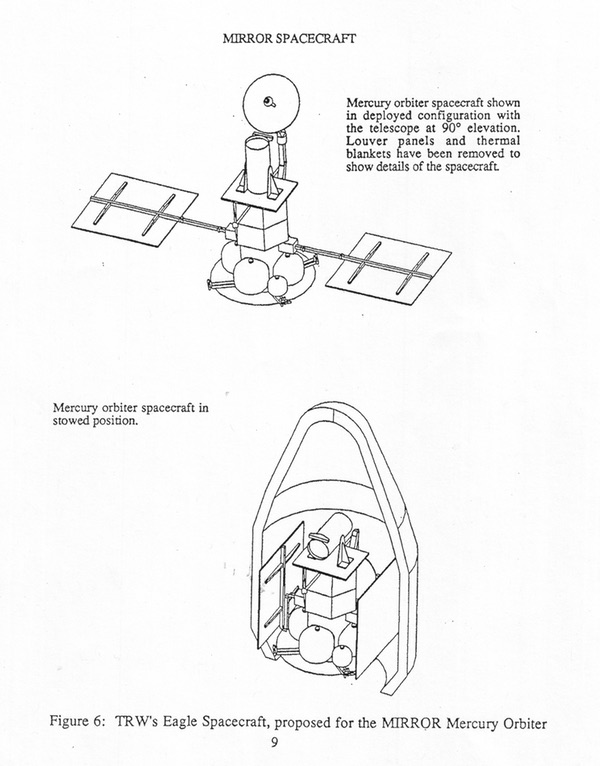 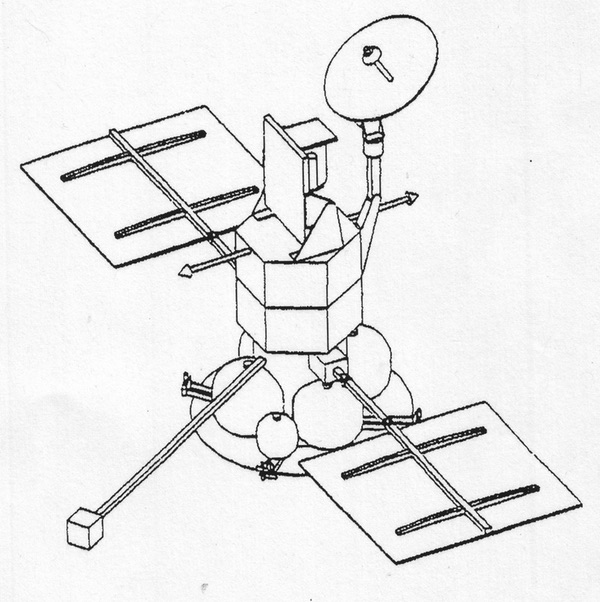 The Mercury Imaging and Radar Ranging Orbital Reconnaissance (MIRROR) spacecraft proposal (top) and the Hermes Mercury orbiter proposal of 1992. Both were based on the TRW Eagle small spacecraft bus. There were many proposals for Delta II-class Mercury missions during a 1992 workshop, indicating substantial interest in the planet and a belief that small missions to Mercury were now possible. (credit: Author’s collection) |
Bruce Bills, who worked in the Geodynamics Branch of NASA’s Goddard Space Flight Center proposed a Mercury mission named Mallcu, the Aymara name for the Andean Condor, mythic companion of the Sun god. Mallcu would enter polar orbit around Mercury with the goal of determining the planet’s figure and center of mass, characterize its tidal amplitudes and phases, quantify its volcanism, characterize its tectonic history, investigate its impact cratering, estimate its internal density distribution, clarify the origin and nature of its magnetic field, and assess Mercury’s surface reflectivity.
Mallcu would carry only a few instruments. The primary one would be an instrument similar to the Mars Observer Laser Altimeter (or MOLA). The Mercury version would be smaller to prevent overheating of large aperture optics so close to the Sun. Other instruments would include a magnetometer and a camera. Observations of the spacecraft’s orbit around Mercury would allow scientists to develop a gravity model for the planet. Mallcu would have an unusual thermal protection system, deploying two large shades, looking sort of like parasols, on either side of the spacecraft. Made of beta cloth, one would shield from the Sun, the other would shield from sunlight reflected by Mercury.
The Hermes Global Orbiter mission would use a Delta II rocket to launch a 300-kilogram three-axis-stabilized spacecraft based upon TRW’s Eagle spacecraft that the company was providing for several Air Force low Earth orbit missions. The spacecraft would enter a 12-hour polar orbit around Mercury with a low point of 200 kilometers and a high of 15,000 kilometers. The spacecraft would use a shade and passive radiation to stay cool. Hermes would carry a visible camera, laser, laser detector unit, UV spectrometer and magnetometer. It had an estimated cost of $146 million.
Duane Muhleman of Caltech proposed a spacecraft that, like Hermes, used TRW’s Eagle satellite bus. The proposal was called MIRROR, the Mercury Imaging and Radar Ranging Orbital Reconnaissance spacecraft. Jacob Trombka of NASA Goddard proposed a scaled-down version of Goddard’s Mercury Orbiter mission. The Mercury Field and Surface Dynamics mission would have used only one spacecraft instead of two, and launched on a Delta II rocket, but other details are unavailable.
Paul Spudis of the Lunar and Planetary Institute proposed a Mercury Polar Flyby mission that would fly past the planet two or three times, approximately every six months, making observations of its poles, which were suspected of containing water ice. The primary science questions were to determine if the polar caps are composed of water ice and to measure the temperature, extent, and purity of the polar ice. The spacecraft would also seek to answer the geology of Mercury. The minimum requirement was for one polar pass and one equatorial pass. The spacecraft would have a dry mass of 375 kilograms and an injected mass of 880 kilograms. It too would use a Delta launch vehicle.
| Despite the renewed interest in Mercury, it still took many years for a mission to be proposed, selected, and launched. |
Spudis’ spacecraft would be three-axis stabilized and include articulated solar arrays, a modular construction with eight avionics bays, a gamma-ray spectrometer boom, and a rigidly mounted pre-deployed shade. According to Spudis, these design features were proven on Mariner 10. The instruments would include a neutron/gamma ray spectrometer, a thermal emission spectrometer, a narrow-angle camera, and a radar sounder-scatterometer. The goal was to build the mission for $140 million.
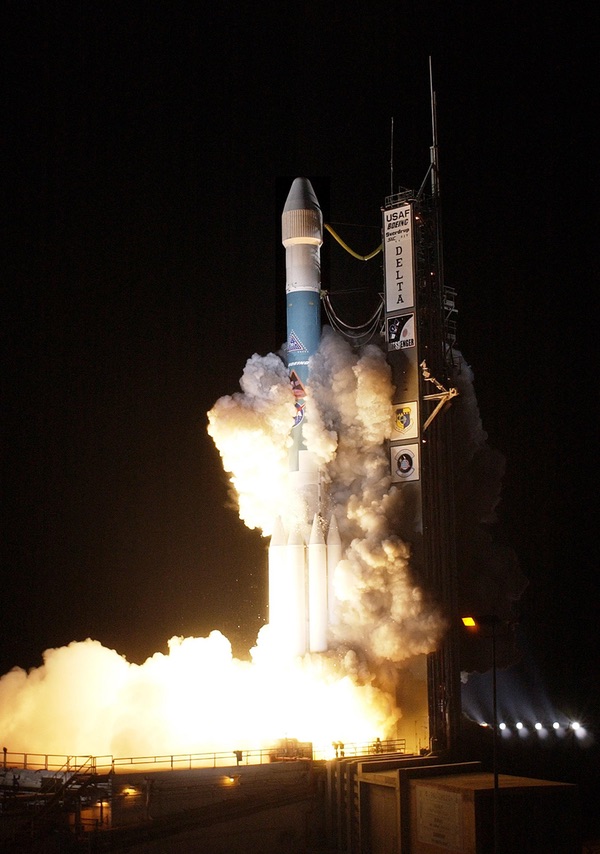 Launch of the MESSENGER spacecraft in 2004. The improvement in trajectory options for Mercury made it possible to launch a spacecraft on a Delta II rocket and still place a substantial science payload in Mercury orbit. (credit: NASA) |
Discovery to Mercury
Despite the renewed interest in Mercury sparked by Chen-Wan Yen’s 1985 trajectory calculations, and despite the numerous Mercury mission studies of the late 1980s and early 1990s, it still took many years for a mission to be proposed, selected, and launched.
In 1996, NASA held a Discovery mission competition. One of the competitors was the Mercury Surface, Space Environment, Geochemistry and Ranging mission, otherwise known as MESSENGER. In October 1997, NASA selected the Genesis and CONTOUR missions, but not MESSENGER. CONTOUR later suffered an in-flight failure, but Genesis was successful in returning cometary dust samples to Earth. In 1998, the agency held another Discovery competition, and MESSENGER competed again. In July 1999, NASA selected Deep Impact and MESSENGER as its next two Discovery missions. Both missions had a cost cap of $300 million and late 2004 launch dates.
MESSENGER reached Mercury orbit in 2011, and for the next several years it extensively studied the planet, providing data that is still being analyzed. The Applied Physics Laboratory built MESSENGER and equipped it with a heat shield that kept it cool throughout its mission—and also gave APL sufficient experience to later build the Parker Solar Probe, which will operate in an even more hellish environment. In 2015, its fuel depleted, MESSENGER crashed into Mercury’s surface.
MESSENGER’s design, and its science, helped inform the development of the BepiColombo mission, which will conduct a much more extensive study of Mercury. Assuming that all goes to plan, BepiColombo will soon start its journey to Mercury, and when it reaches orbit in 2025, it will be in part due to the calculations of a JPL scientist 40 years earlier.
Note: we are temporarily moderating all comments subcommitted to deal with a surge in spam.
